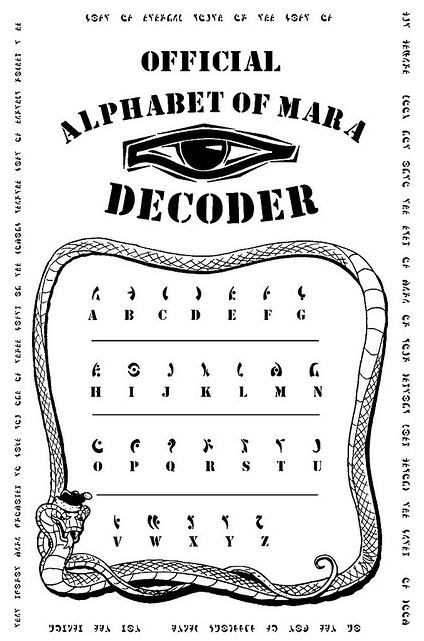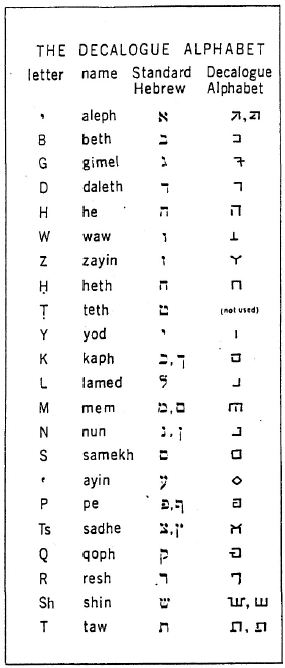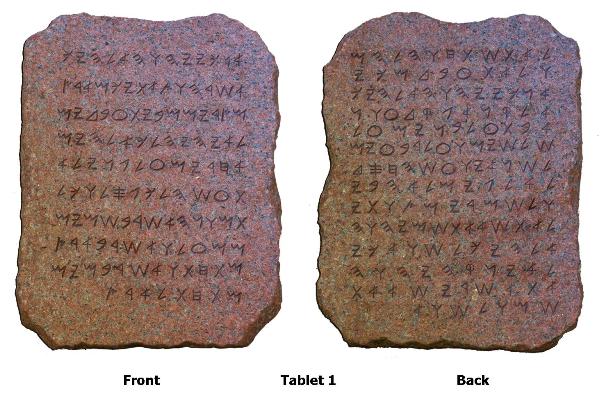|
The Ohio Decalogue Stone,
rounded at the top and squarer at the bottom in stereotypical
stone tablet fashion. The characters are not standard Hebrew. Telltale substitution blunders reveal what the hoaxer didn’t want you to
know: that the source of the inscription is contemporary - from a
Hebrew Bible.
Messages of foreboding in what appears to be
a form of ancient eastern writing are seen at Disneyland’s Indiana Jones
attraction - the Temple of the Forbidden
Eye. How can you tell the messages in “Marabic” are foreboding? Because
they're in English – with a decoder you can read them!

Of course Disney imagineers were not the first to make
up an alternate alphabet for an established language! The Ohio Decalogue Inscription
is a 19th century example.
Suppose you want to engrave the Hebrew Ten Commandments
in
stone. Carving the letters found in printed Bibles could
be very difficult! You might think of changing the Hebrew alphabet
(aleph-bet) so the characters
are easier to carve! Like this:

From An Annotated
Transcription of the Ohio
Decalogue Stone, J. Huston McCullough (August, 1992)
On the extreme right in the table above, are the
contrived characters of the Ohio Decalogue Stone. These letters are
matched with the long established aleph-bet found in today’s Hebrew Bibles.
The standard Hebrew (Aramaic) aleph-bet has been in use since the return of the Jewish
people from Babylonian exile. Take a look at the standard Hebrew letters
heading
Psalm 119 (King James
translation). These symbols are not the
same as the ancient symbols that the psalmists David and Asaph used.
Standard Hebrew letters have replaced the Phoenician like letters that very ancient Hebrew
texts were originally written in.
The Hebrew of Lehi’s and Jeremiah's time was
written with Phoenician-like letters - letters like those carved on the
rather plain
Tennessee Mound Tablet, also known as the Bat Creek Stone.
Mormons especially, should pay attention to this fact! The standard Hebrew
alphabet used in Bibles today is post Lehi! Standard Hebrew would not have been
familiar to the Book of Mormon patriarch, let
alone the
improvised writing on the Ohio Decalogue Stone.

The 10 Commandments, written in the plain but very
ancient Hebrew familiar to Lehi
The Decalogue of Lehi’s day, and earlier, was written in Phoenician like letters - letters which would
have been much easier to engrave than post exilic Hebrew letters in use
today.
Evidently, the fabricator of the Ohio Decalogue
inscription wasn't familiar with the ancient and more
original Hebrew aleph-bet. Had he known ancient Hebrew he wouldn't have seen a need to make
up a substitute alphabet. Memo to charlatans: If you’re not going to make a
stone inscription of the Ten Commandments in ancient Hebrew, your
better off copying the text from a source like the Greek Septuagint. Then at least
you can make the plausible claim that the stone was carved by Hebrews from a
later time period – e.g. Greek speaking Jews from
Alexandria
or maybe even Christians.
But
the hoaxer decided to invent a substitute
aleph-bet. He proceeded to edit the
biblical text of the Ten Commandments, keeping the main parts,
and counting the number of letters in the string to be carved. Since the made-up letters conveniently occupied square spaces of about the same size,
the hoaxer did a little figuring to determine the size of stone needed to
accommodate the whole text. He took into consideration the length of the
string of letters, and the standard sized space that he wanted for each
letter. He also added in the space needed for a graven image. He wanted to
use up all the available surface of the stone; front, back, and sides, so
folks would be really impressed with the craftsmanship and the text’s exact fit!
This brings up an important point: If you’re going
to plan things so that you use up all the available writing space on the
stone, you’d better not leave out important Hebrew characters like “et” (את)
which indicates a verb’s direct object, but which has no meaning or
translation in English! Sure you can read the Bible in English, but if you
leave out something seemingly “meaningless” like את
it would be a noticeable mistake in Hebrew! If you plan all the letters to
fit perfectly on the stone and you stupidly leave out את
or other letters, someone who truly knows Hebrew will probably get
suspicious of the inscription! Actually the Ohio Moses Stone does
ignore an “et” as well as other letters, and yes the text all too cleverly
fits the stone’s writing surface. Oops!
Let's say you correctly transfer the Hebrew from the Bible to your improvised alphabet, how will you clue in the curious
to the fact that the stone is really inscribed with Hebrew verse - they may not
recognize your substitute alphabet? Hey, I have an idea: There could be a
big cameo (graven image) of Moses centered on the stone’s face, with his
recognizable Hebrew name inscribed like rays above his head! You could even
replace the hard to carve standard Hebrew “mem” (מ),
beginning the Law givers name, with a character that looks just like a
common Latin “m”. See table above. Someone learned is sure to catch on that
the stone is inscribed with holy verse when they plainly discern the
name of the Law giver!
In fact, why not make the name of Moses lead into
the inscribed verse? Hmmm, there’s a problem here! The Hebrew Bible verse
doesn't begin by recognizing Moses, but by recognizing God! Well that’s
easy to fix! Even an amateur with some basic resources like
a Hebrew dictionary, can eventually pick out the part that reads “I am the LORD
your God”
(Shemot (Exodus) 20:2). This part could be cut from the start of
the verse and stuck at the end of the verse, so it flows into the verse that
follows! Yep, that works, even if it does seem rather Gentile minded to credit
Moses with delivering Israel.
Here then is the intended text behind the Ohio
Decalogue inscription, rearranged and edited from available Hebrew Bible
verses. [1] Understand that this is the
text that the scribe tried to convert into the simplified, but contrived
alphabet shown in the table above. Don’t expect the Hebrew to flow word for
word in the same order as the English translation. The standard Hebrew in
its authentic syntax is accompanied by portions from the Authorized King James
translation (KJV) on the right:
מֹשֶׁה
;מֹשֶׁה
Moses
2
אֲשֶׁר
which
הוֹצֵאתִיךָ
have brought thee
מֵאֶרֶץ
out of
the land of
מִצְרַיִם
Egypt,
מִבֵּית out of
the house of
עֲבָדִים ׃ bondage.
אָנֹכִי אָנֹכִי I
am
יְהוָה the LORD
אֱלֹהֶיךָ thy God,
OOPS!
Commentary on the Ohio Decalogue transcription of verse 2:
When it came to converting
the Hebrew expression
הוֹצֵאתִיך,
which means “have brought thee”, the Moses Stone scribe
foolishly mistook the
letter
ו
for a ד.
These Hebrew letters may look similar to some folk, but someone who actually
reads and writes Hebrew would know the difference instantly. The real
problem here is that the invented Moses Stone symbol that the scribe
substituted for ד
does not look at all like the substitute symbol for
ו.
Do you see the problem? See for yourself. Check out the table above and make the comparison.
So if the substitute
alphabet was really used as an archaic writing system, how could the writer
possibly have confused the two letters, which were made to look so very
different in the
Ohio alphabet?
Understand that these letters sound very different when spoken. The mess-up
here leads to non-sense? This mistake isn’t just a spelling error mind you!
It is plain to see how the blunder took place: The scribe was actually
trying to convert letters, albeit naively, from a standard Hebrew text
(where they look similar) into a made-up alphabet where the corresponding
letters were made to look different! Keep your eye out for this type of
blunder – it happens again and again in the Moses Stone
transcription. See source
[2]
for the transcription.
3
לֹא
no
יִהְיֶה־לְךָ Thou shalt have
אֱלֹהִים
gods
אֲחֵרִים
other
עַל־פָּנָיַ ׃ before
me.
OOPS! Commentary on the
Ohio
Decalogue transcription of verse 3:
The Hebrew word “elohim”
(אֱלֹהִים)
in verse 3 (KJV) is badly mutated on the Moses Stone. UNFORGIVABLE!
The scribe was apparently insensitive to this very important Hebrew word for
“GOD” or “gods”. It is as if he saw in the Hebrew letters
הִי
in
אֱלֹהִים
a single Hebrew letter
מִ. Not only that, the scribe confused
the Hebrew letter
ם in
אֱלֹהִים
with the Hebrew letter
ח. Oblivious to the
actual Hebrew word he was
attempting to transcribe, the scribe made
out “elmh”
(אֱלמח)
– which is nonsense! See source
[2] for the
transcription.
4
לֹא
not
תַעֲשֶׂה־
Thou shalt make
לְךָ unto thee
פֶסֶל
any graven
image,
וְכָל־
or any
…
OOPS!
Commentary on the Ohio Decalogue transcription of verse 4:
Bad edit job here! The
Moses Stone leaves the sentence incomplete, leaving off at
וְכָל־. If the intent of the scribe
was to abbreviate this commandment, he should have left off at
פֶסֶל. The scribe did not
understand everything he was copying. He may have gotten confused because
the sequence of Hebrew words in the verse does not correspond one to one
with the accompanying English translation. He may not have known for sure
where to truncate the verse. See source
[2]
for the transcription.
5
לֹא־ not
תִשְׁתַּחְוֶה
Thou shalt bow down thyself
לָהֶם
to them,
וְלֹא nor
תָעָבְדֵם
serve them:
…
OOPS! Commentary on the
Ohio
Decalogue transcription of verse 5:
Here the Moses Stone
exhibits more confusion! The scribe saw
תִשְׁתַּחְוֶה
as
חִשׁתַּחְוֶח,
which makes no sense! The scribe did not understand the meaning of
the composite Hebrew expression that translates,
“Thou shalt not bow down thyself” (לֹא־תִשְׁתַּחְוֶה)
and made two wrong substitutions. The scribe also mistook the
ת
in
תָעָבְדֵם
for a
ח
– more nonsense! See source
[2]
for the
transcription.
6
…
7
לֹא
not
תִשָּׂ Thou
shalt take
אֶת־
שֵׁם־ the
name of
יְהוָה the LORD
אֱלֹהֶיךָ
thy God
לַשָּׁוְא in vain;
…
OOPS! Commentary on the
Ohio
Decalogue transcription of verse 7:
Verse 7 vainly puts a
י
in place of the
ו
in the Tetragrammaton (the sacred ineffable name of Deity - the Eternal).
Did the scribe mistake the divine name in verse 7 for a
יִהְיֶה;
like the one he correctly transcribed in verse 3? Hmmm! What if
Israelites in ancient American changed the spelling of the divine
name? How then do we account for the fact that the divine name
from verse 2 was correctly transcribed on the stone? The misspellings are
not consistent on the stone! See source
[2] for the transcription.
8
זָכוֹר
Remember
אֶת־
יוֹם
day,
הַשַּׁבָּת the sabbath
לְקַדְּשׁוֹ ׃ to keep
it holy.
OOPS! Commentary on the
Ohio
Decalogue transcription of verse 8:
As with other verses, the Moses
Stone transcription of verse 8 is definitely based on the Masorah (the
available Hebrew text from which the KJV Old Testament was translated). Here
the scribe labored to put a
ח
where there should be a
ה in
הַשַּׁבָּת,
“the Shabbat”. The scribe apparently
didn’t know that the attached letter “hey” (ה)
means “the” (i.e. “the Shabbat”), whereas attaching a look-alike “het”
(ח)
to “Shabbat” (instead of a “hey”
ה)
is meaningless! The scribe also leaves out the
ק
in
לְקַדְּשׁו.
The fact that the misspelled and poorly edited text fits the stone’s surface
isn’t so remarkable after all. See source
[2]
for the transcription.
9
שֵׁשֶׁת Six
יָמִים
days
תַּעֲבֹד shalt thou labour,
וְעָשִׂיתָ and do
כָּל־
all
מְלַאכְתֶּךָ thy work:
OOPS!
Commentary on the Ohio Decalogue transcription of verse 9:
The scribe failed to pluralize “day”. The Moses Stone
reads, “Six day ….” See source
[2] for the
transcription.
10
…
11
…
12
כַּבֵּד
Honour
אֶת־
אָבִיךָ
thy father
וְאֶת־
and
אִמֶּךָ thy mother:
…
OOPS!
Commentary on the Ohio Decalogue transcription of verse 12:
Here the dishonorable
transcription leaves out the Hebrew direct object indicator “et” (אֶת־)
in “Honor et thy father…” But wouldn’t you know, the transcription
keeps the
אֶת־
in “…and et thy mother”. In this case there is an “and” (וְ)
attached to the “et” like so:
וְאֶת־.
To the English speaking scribe “and” meant something! Maybe the scribe
thought the whole
וְאֶת־
indicated “and”.
The scribe may have had
a hard time understanding the significance of
אֶת־
in the first instance, and for that reason left it out.
[3]
See source
[2]
for the transcription.
13
לֹא
not
תִּרְצָח Thou shalt kill.
OOPS! Commentary on the
Ohio
Decalogue transcription of verse 13:
Here the Moses Stone
transcription murders the language by confusing the standard Hebrew “tsadi”
(צ)
in
תִּרְצָח
for an “ayin” (ע).
If the scribe had planned better (short of actually learning Hebrew), he
could have made these letters look more similar in the phony alphabet – to
cover up this kind of blunder! As it is, someone who knows Hebrew can tell
that the scribe was transcribing from a standard Hebrew text, and that the
he didn’t really know the letters very well much less the words. The
transcriber also mistook the
ח
at the end of
תִּרְצָח
for a
ת.
The scribe had a hard time telling the difference between
ח,
ת,
and
ה,
all of which make different sounds. If Disney imagineers had made comparable
transcription errors in “Marabic”, paying guests, passing the time in
line would have complained!
See source
[2]
for the transcription.
14
לֹא
not
תִּנְאָף Thou shalt
commit adultery.
OOPS!
Commentary on the Ohio Decalogue transcription of verse 14:
Here the transcriber adulterated
the transcription by confusing the “nun” (נ)
in
תִּנְאָף
for a “lamed” (ל).
See
reference
[2] for
the transcription.
15
לֹא
not
תִּגְנֹב Thou shalt steal.
16
לֹא־
not
תַעֲנֶה Thou shalt bear
בְרֵעֲךָ
against thy neighbour.
עֵד witness
שָׁקֶר false
OOPS!
Commentary on the Ohio Decalogue transcription of verse 16:
The false
inscription confuses the letters
נה
in
תַעֲנֶה
for the letters
לח.
See source
[2]
for the
transcription.
17
לֹא not
תַחְמֹד Thou
shalt covet
בֵּית
house,
רֵעֶךָ
thy
neighbour's
לֹא־ not
תַחְמֹ
thou
shalt covet
אֵשֶׁת wife,
רֵעֶךָ thy
neighbour's
וְעַבְדּוֹ nor his manservant,
וַאֲמָתוֹ nor his maidservant,
וְשׁוֹרוֹ nor his ox,
וַחֲמֹרוֹ nor his ass,
וְכֹל nor any
thing
אֲשֶׁר that
is
לְרֵעֶךָ thy neighbour's.
OOPS! Commentary on the
Ohio
Decalogue transcription of verse 17:
Blundering his way to the
end, the scribe mistook the
ד in the first
תַחְמֹד for a
ך.
It’s easy to see how these Hebrew letters could get confused, but
the specious Moses Stone replacements for these letters are very
different looking! Which begs the old question, how could this possibly be a
simple spelling error? It can’t be!
The next
תַחְמֹד
appears to be transcribed correctly! At least there is the benefit of a
doubt here, because the first and last letters are worn. The expression
רֵעֶךָ
בֵּית
on the Moses Stone is unintelligible! The scribe inanely put
ועך
ביו.
The scribe also mistook
the “raysh” (ר)
in “thy neighbor” (רֵעֶךָ)
for a “vav” (ו).
Again it is easy to see how someone who is looking at standard Hebrew could
confuse these letters – not knowing the language! But the Moses Stone
substitutions for these letters look so very different that the blunder
cannot be chalked up to a simple writing error! The scribe isn’t consistent
in repeating his mistake! The same expression, “thy neighbor”, is correctly
transcribed in the phony alphabet at the end of the verse (as also in verse
16) – proving that this is not some standard spelling change in an ancient
language.
The inscription drops the
וֹ
in the middle of
וְשׁוֹרוֹ.
This at last, is a forgivable oversight. Even so, the Ohio Moses Stone
was definitely not crafted by
one fluent in Hebrew. See source
[2] for
the transcription.
There are
egregious, telltale transcription errors in almost every verse!
Conclusion:
The Ohio
Decalogue is a hoax. It is not the work of an ancient American Israelite.
But why on earth would anyone undertake such a work?
Actually, the stone fits all too well the American “Mound
Builder” mythopoeic interests of the 19th Century. More
than Mormons had an interest in convincing the world that the American
Indians descended from lost tribes of Israel. There were other hoaxes of this type foisted
on the American public! Regrettably, “archaeological” fraud
besets the
study of the Bible and the Book of Mormon.
References:
[1]
LDS Scriptures with Advanced Study Aids
CD-ROM,
transliterate Hebrew / English of
Shemot
(Ex.) 20:2 – 17 .
[2]
J. Huston
McCullough, “An Annotated Transcription of the
Ohio Decalogue Stone”, August, 1992.
[3]
Brown-Driver-Briggs-Gesenius Hebrew-Aramaic Lexicon,
אֵת,
853-854, pp. 84-86.
Vincent Coon
כּוּן
וִינְסֶנט © Copyright 2012
Beware of Mark Hofmann’s Anthon Transcript Forgery!
|